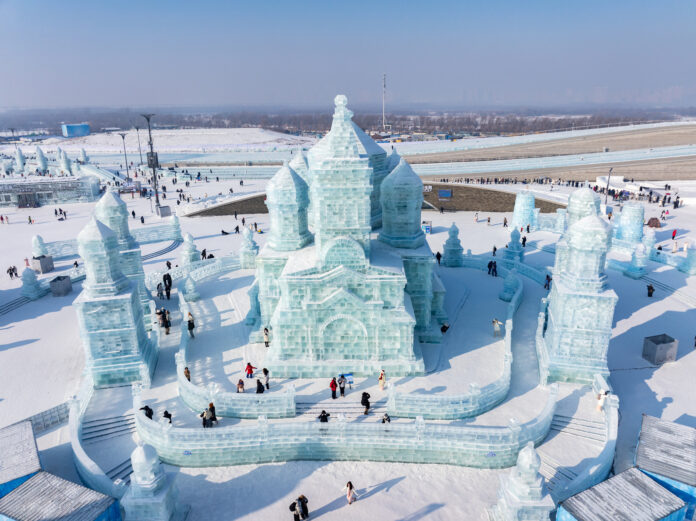By Yi Xin
Every winter, Harbin, known as the “Ice City” in China’s northeastern Heilongjiang Province, transforms into a vibrant wonderland of ice sculptures, winter sports, and joyful snowball fights. This year, the 9th Asian Winter Games, which kicked off on February 7, has further amplified this excitement, welcoming over 1,270 athletes from Pakistan and other 33 Asian countries and regions—a record high in terms of participants. Pakistani President Asif Ali Zardari’s attendance at the opening ceremony highlights the importance of this event.
Ice and Snow: Fueling High-Quality Development
The Beijing Winter Olympics in 2022 set off a ripple effect that continues to be strongly felt today. China’s vision of engaging 300 million people in winter sports, a commitment made during its 2022 bid, has become a reality. The passion for ice and snow has swept across the country, creating immense excitement and significant economic opportunities.
In Harbin, attractions like the Ice and Snow World, Sun Island International Snow Sculpture Art Expo, and Songhua River Ice and Snow Carnival have drawn both domestic and international tourists in droves, transforming a once-frozen landscape into a thriving business hub. The ice and snow economy has become a new driver of high-quality development, not only for Harbin but also for the province and the entire country.
During the recent Spring Festival holiday, Heilongjiang (Harbin is the provincial capital of Heilongjiang Province) received 26.263 million visitors, generating a total spending of 33.65 billion yuan. Data also shows that by 2025, China’s “ice and snow industry” is expected to reach a scale of over 1 trillion yuan.
Ice and snow events are no longer exclusive to northeastern China. The southwestern city of Chongqing hosts 150 such events and introduces 80 winter tours; in Guangdong, indoor skiing facilities cater to ski enthusiasts year-round, free from geographical or seasonal limitations; in Altay, Xinjiang, winter folklore and bed-and-breakfasts are gaining popularity. All these have significantly boosted “winter consumption.”
The booming of ice and snow economy in China also means more opportunities for the world. For example, the Chinese government released a document in 2024, vowing to harness the development of a
“China-Shanghai Cooperation Organization (SCO) lee and Snow Sports Demonstration Zone” and promote mutually beneficial cooperation with relevant countries. This is a boon for cooperation on ice and snow economy with SCO members including Pakistan, which may help raise the publicity of Pakistani winter sports attractions among Chinese tourists and boost ice and snow tourism in Pakistan. Indeed, ice and snow can be valuable assets for all.
Ice and Snow: Witnessing a More Open Harbin and a More United Asia
Ice and snow culture is forging new bonds that link Harbin with the rest of Asia. “If Elsa from Frozen were to visit, she’d be enchanted by the beauty of our city and this marvelous event,” Harbin citizens joked. Well, it’s entirely possible. Thanks to China’s visa-free policy and the steady increase in international flights, it’s much easier for foreign tourists to embark on their “China Travel and experience a unique winter.
The current Asian Winter Games is more than just a grand sporting event; it is also a platform for people from different cultural backgrounds to learn from each other. It’s a gathering that showcases Asia’s distinctive culture, one that values mutual respect, equality, and inclusiveness. No matter where they came from, tropical islands or snowy mountains, athletes competed and made friends here. With them, the city has become a showcase of the dynamism and potential of Asian winter sports and the unity among Asians.
Beyond the arena, leaders from Pakistan, Brunei, Thailand, Kyrgyzstan, and the Republic of Korea visited China to deepen communication and advance cooperation, further solidifying the foundation for a shared future in Asia.
A Brighter Future Built on lee and Snow
In this enchanting world of ice and snow, a brighter future is being built, one where joy, development, and solidarity thrive. Harbin’s ice sculptures will slowly melt as spring approaches, but the impact of the 2025 Asian Winter Games will go on, and the spirit of unity and shared future will continue to inspire.
The theme of this Asian Winter Games, “Dream of Winter, Love Among Asia,” captures the essence of this spirit, a consistent appeal of China.
Just like the 2008 Beijing Olympics that championed “One World, One Dream” and the 2022 Beijing Winter Olympics that brought people
“Together for a Shared Future,” the Asian Winter Games in Harbin will continue to inspire unity in the years ahead.
The author is a Beijing-based observer of international affairs.























